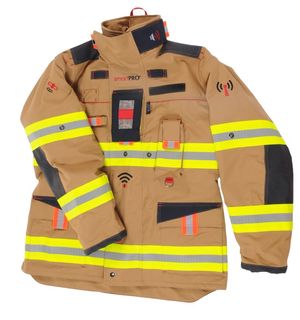KANBrief 2/20

Personal protective equipment with integrated intelligent functions (smart PPE) holds the promise of enhanced protection. However, for smart PPE to be developed successfully and brought to market, users must be involved in the development process (user-centred design). A user survey conducted throughout Germany on smart PPE for use by the fire services has revealed valuable information.
Firefighters are exposed to particularly critical ambient conditions. Smart PPE is therefore particularly suitable for this user group. 150 firefighters from voluntary, works and professional fire services throughout Germany took part in a survey conducted by RWTH Aachen University, in cooperation with KAN and the Institute of Fire Service and Rescue Technology (IFR) in Dortmund. Approximately 95% of the survey respondents considered PPE with smart functions to be useful. However, the majority of the firefighters had previously had no personal experience of smart PPE.
The firefighters expressed the view that their location (geolocation and positioning; 85%) and pulse (70%) in particular should be monitored with the aid of sensors. Another useful function mentioned was the monitoring of the core body temperature. Among the ambient parameters, the survey respondents considered determining of the ambient temperature (85%) and detecting harmful/toxic substances in the air to be useful.
Various methods can be used to warn firefighters of danger during a deployment. The survey respondents were able to choose between tactile (vibration), optical (lights) and acoustic signals. The three options met with broadly the same positive response, with values of between 60% and 70%. In addition, the firefighters suggested a display in the respiratory mask.
Just under 60% of the survey respondents considered it advantageous for an automatic emergency call to be made in a dangerous situation. Only 15% took a critical view of this function. One reason given was data protection, another the fact that human vital functions differ between individuals, making it difficult or even impossible to determine generic critical values. A further important point made was that a deployment site often presents no alternative to staying and providing assistance. Substitution with a colleague would not therefore be an option. Around 55% of the survey respondents would trust the smart functions more than their own perception. A majority (around 60%) would prefer to decide for themselves how their personal data are collected, interpreted and forwarded. Only 10% would agree to long-term analysis by third parties, such as accident, health or other insurance institutions.
Overall, the user survey reveals interest in smart PPE for use in firefighting operations. However, since the majority of respondents had never experienced smart PPE themselves, information events must be held. Workshops can be held at which prototypes are presented and the benefits explained to the users. This may lead to greater acceptance among users. The use of smart PPE during fire drills may also be conducive to acceptance; this would enable the ease of use and wear comfort to be reviewed and improvements made. Processing of the personal data presents a challenge. These issues must therefore be clarified beforehand.
The survey reveals the desire for means of geolocation and positioning. Smoke and fog considerably impair firefighters’ visibility and can result in a loss of orientation. A geolocation function would enable them to determine their positions and those of their colleagues. The existing technology is however limited in its ability to locate firefighters inside buildings. The development of smart PPE should therefore focus particularly on this aspect. Another important point is the wear comfort of PPE. This must not be impaired further by the integral smart functions.
The results of the survey will be taken up in research projects. This is to enable an orientation tool to be produced for the development of smart PPE. The requirements identified could also be used directly for current developments. European fire services are also being consulted.
Rahel Krause
rahel.krause@ita.rwth-aachen.de